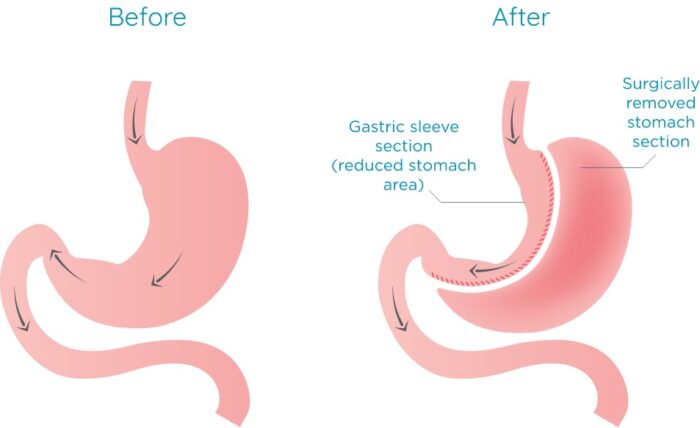
Laparoscopic Gastric Sleeve weight loss surgery, also called Vertical Sleeve Gastrectomy (VSG) or Gastric Sleeve Resection, is currently the most common bariatric surgery procedure performed in the United States. This procedure involves the removal of roughly 80% of the patient’s stomach.
Not only does removing a significant portion of the stomach dramatically limit the amount of food (and calories) a patient is able to consume, but it also reduces production of the hormone ghrelin. This hormone triggers the appetite, helping patients to feel less hungry.1
The Gastric Sleeve Procedure
The Gastric Sleeve procedure is performed laparoscopically at Panhandle Weight Loss Center. This means that the surgeon will make five or six small incisions in the patient’s abdomen, then use a special video camera (laparoscope) and long, thin surgical instruments to complete the operation.
During a laparoscopic Sleeve Gastrectomy, the surgeon uses a stapling device to remove 75 to 80% of the stomach, leaving a narrow “tube” or “sleeve.” This surgery is complete in one to two hours, and does not involve re-routing the intestines as some other bariatric procedures do.

Gastric Sleeve Recovery
Because Gastric Sleeve surgery is performed laparoscopically, most patients are able to return home the same day as their weight loss surgery and encounter relatively brief recovery periods. On average, patients are able to return to work 1 week after their gastric sleeve procedure. Many patients from Amarillo or patients who travel to Panhandle Weight Loss Center are eligible to undergo Sleeve Gastrectomy under our ACCELERATE Program.
Gastric Sleeve Follow-Up and Aftercare
In order for patients to increase their odds of success following Gastric Sleeve surgery, it is important that they continue to follow up with their Panhandle weight loss team. Aftercare includes visits with a Physician Extender who can identify any surgical complications, make adjustments to the patient’s medications, and monitor the patient for potential vitamin and mineral deficiencies. Other members of our patients’ aftercare teams include dietitians, health coaches, and psychologists.
For more information on what patients can expect before, during, and after Gastric Sleeve surgery, we invite you to view our Bariatric Surgery Manual.
Gastric Sleeve Results
Within two years of surgery, the average Gastric Sleeve recipient loses up to 65% of extra weight. Patients also show marked reduction in or even resolution of obesity comorbidities including:
- Type 2 diabetes (remission in 75% of patients)
- Sleep apnea (all patients in a recent study were able to stop using CPAP masks)
- High blood pressure (71.7% of patients see full remission)2
Your Gastric Sleeve Surgery Consultation
If you have a BMI of 30 or more and have been diagnosed with obesity-related conditions such as Type 2 diabetes, sleep apnea, or high blood pressure, you may be a good candidate for Gastric Sleeve surgery. At Panhandle Weight Loss Center in Amarillo, Texas, we help patients from all over the United States lose weight to embrace healthier and more fulfilling lives. To learn more about your weight loss options, please contact us today for a private consultation.

Comparison of Surgical Procedures
| Banding | Sleeve Gastrectomy | Gastric Bypass | Duodenal Switch | |
| Invasiveness | Least | Middle | Most | Most |
| Excess Weight Loss | 40-60% | 50-65% | 50-70% | 80-90% |
| Rate of Weight Loss | Slower | Faster | Fastest | Fastest |
| Complications | Occur Later | Occur Early | Occur Early or Late | Occur Early or Late |
| Adjustable | Yes | No | No | No |
| Reversible | Yes | No | Very Difficult | Very Difficult |
| Implanted Device | Yes | No | No | No |
| Hospital Stay | < 1 Day | < 1 Day | 1 – 2 Days | < 1 Day – 1 Day |
| Time Off Work | 1 Week | 1-2 Weeks | 2 Weeks | 2 Weeks |
| US Track Record | Since 1991 | Since 2000 | Since 1960s | Since 1950s |
| Anti Inflammatory | Ok | Ok | Not Ok | Ok |
| Follow Up | Most Frequent | Least Frequent | More Frequent | More Frequent |
| Weight Regain | Yes | Yes | Yes | Less Likely |
| Convert Procedure to Another | Yes | Yes | Difficult | Yes |

Are You a Candidate for Our Weight Loss Programs?
Take our 60 Second Assessment
1 American Society for Metabolic and Bariatric Surgery. Sleeve gastrectomy. Available: https://asmbs.org/patients/bariatric-surgery-procedures#sleeve. Accessed September 9, 2020.
2 Hoyuela C. Five-year outcomes of laparoscopic sleeve gastrectomy as a primary procedure for morbid obesity: A prospective study. World J Gastrointest Surg. 2017;9(4):109-117. doi:10.4240/wjgs.v9.i4.109. Available: https://www.ncbi.nlm.nih.gov/pmc/articles/PMC5406732/. Accessed September 9, 2020.
The surgeons at Panhandle Weight Loss Center have either authored or reviewed and approved this content. Page Updated:
